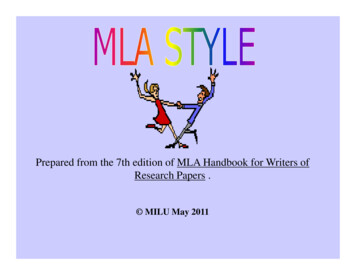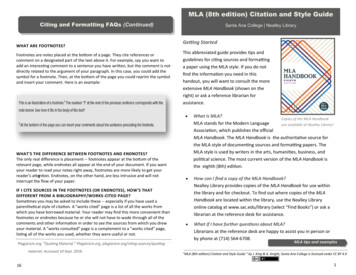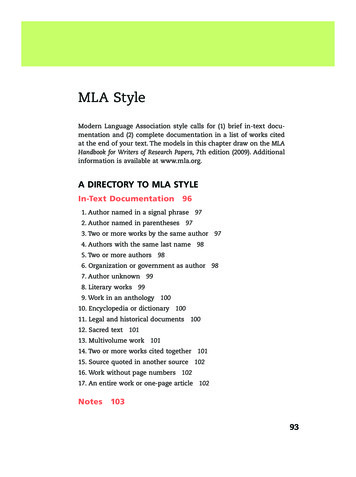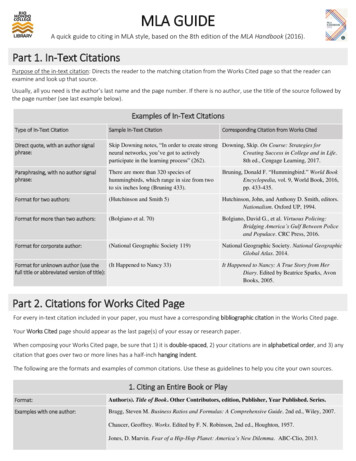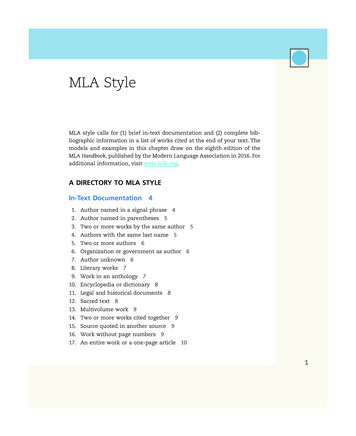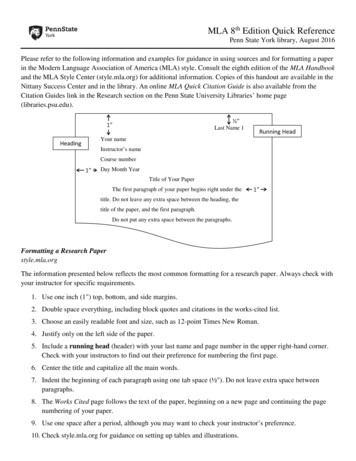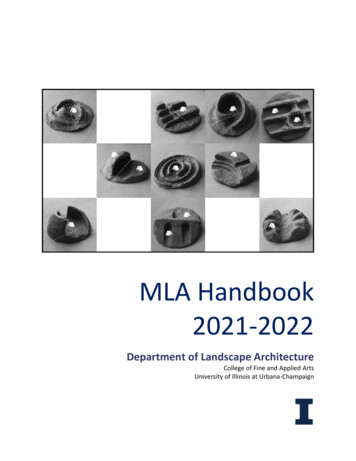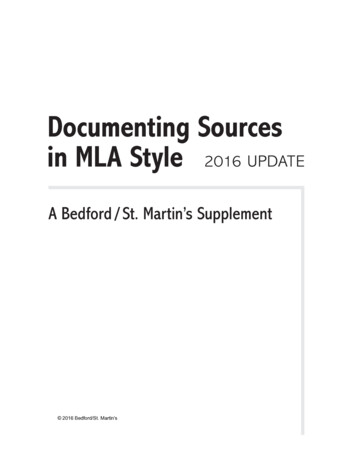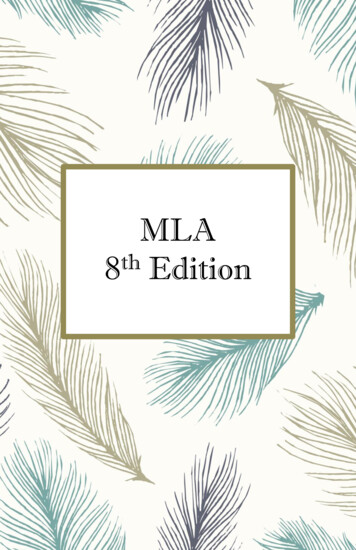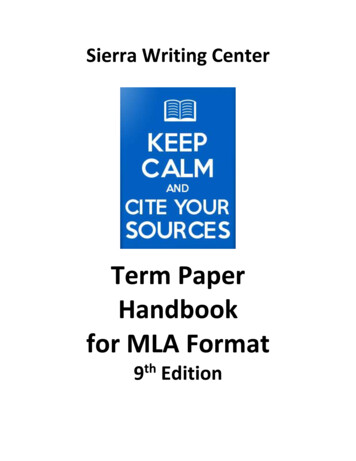
Transcription
Sierra Writing CenterTerm PaperHandbookfor MLA Format9th Edition
CONTENTSMLA-Style Research Paper . 1First Page Format . 1Pagination. 1In-Text Citations—Overview . 3Quoting. 3In-Text Citations (with Examples) . 5Works-Cited Format. 8MLA-Style Documentation Models for a Works-Cited Page . 10Books. 10Book with One Author:. 10Book with Two Authors:. 10Book with Three or More Authors: . 10Short Work or Chapter in a Book (Anthology): . 11Book with Editor(s):. 11Cross-References:. 12Introduction, Preface, Foreword, or Afterword:. 12Book on the Internet: . 12E-book for an Electronic Reader like Kindle or Nook: . 13Sacred Text: . 13Online Sacred Text: . 13Article in a Reference Book: . 13Online Encyclopedia or Dictionary: . 14Academic Journals and Other Periodicals . 15Scholarly Journal Article: . 15Online Scholarly Journal Article (Not from a database):. 15Online-Only Scholarly Journal Article (Not from a database): . 15Magazine Article:. 16Online Magazine Article: . 16Newspaper Article:. 16Online Newspaper Article: . 17Advertisement:. 17Online Advertisement: . 17i
Databases . 18Article from an Online Research Database: . 18Reprint of an Article in a Volume of Literary Criticism on a Database:. 18Abstract of an Article in a Library Research Database: . 19Web Sites. 20Web Site or Home Page: . 20Web Page or Document on a Web Site:. 20Web Page or Document with No Author: . 20Web Page or Document with No Publication Date: . 21Handout Uploaded to Canvas (or other Web site): . 21Legal Citations. 22Bill Online: . 22Federal Law (Act) Online: . 22Court Case Online:. 23Government Documents . 24Government Document Online (Different author and publisher): . 24Government Document Online (Same author and publisher):. 24Communication . 25Lecture:. 25TED Talk:. 25Personal Interview: . 25E-Mail Message: . 25Blog:. 26Tweet:. 26Works of Art . 27Work of Visual Art: . 27Work of Art in a Book: . 27Work of Art Online or in a Database: . 27Performing Arts . 28Live Performance: . 28Sound Recording: . 28Sound Recording Streamed on an App: . 28Song Lyrics Online: . 28Television Episode or Radio Broadcast (Podcast) Online:. 29Movie: . 29ii
Video on a Video-Sharing Web Site like YouTube: . 30Video on a Web Site (Not a video-sharing Web site):. 30Video Game:. 31For More Information . 32Contact the Writing Center . 32Visit the Writing Center Web Page . 32To Download This Term Paper Handbook. 32This handbook includes updated formats from the MLA Handbook, 9th edition, 2021, and The MLA StyleCenter website: style.mla.org.Cover image credit: Simon Fraser University under a Creative Commons Attribution 2.0 (BY-NC)Updated August 2021Sierra College, Rocklin, Californiaiii
MLA-STYLE RESEARCH PAPERSome important aspects of the Modern Language Association (MLA)style paper are exemplified in the following sample pages of a student'sresearch paper.FIRST PAGE FORMATThe first page of an MLA-style paper must include a heading. Theheading begins in the upper-left corner, one inch from the top of the page.It consists of your name, the instructor's name, the course, and the date.Double-space all information. Double-space from the last line of theheading to the title. Center the title. The title should not be boldfaced,quoted, underlined, or italicized. The first letters of the main words shouldbe capitalized. The first line of the essay is double-spaced from the title andindented one half inch (one pre-set tab).PAGINATIONYour last name and page number should appear in a header in theupper right-hand corner, one half inch from the top of all pages, with onespace between your name and the page number.1
Cardoso 1Celeste CardosoProfessor NakaharaPsychology 10029 April 2021The Benefits of Mindfulness Meditation for College StudentsMeditation is a centuries long exercise, but mindfulness is gaining traction today as it hasproven to have many benefits in helping manage stress and improve well-being. Psychologistshave found that mindfulness meditation changes our brain and biology in positive ways,improving mental and physical health (“Stress”). College students are found to be under a lot ofstress that often impairs their ability to focus and perform tasks well due to academic challenges,social changes, or family pressures. Almost half of college students demonstrate some form ofstress resulting in physical ailments such as abdominal pain (Felver et al.). Mindfulness-BasedStress Reduction (MBSR) is found to be an effective method to reduce stress and promotepsychological and physiological health and well-being. Dr. Jon Kabat-Zinn, creator of the Centerfor Mindfulness in Medicine, discusses a mindfulness-based stress reduction program, whichshows how to use natural but medically proven methods to “soothe and heal the body, mind, andspirit . . . MSBR is an established program shown to reduce symptoms of stress, anxiety, anddepression” (5).The ability to manage stress and pay attention to whatever tasks are at hand are importantdeterminers of well-being and successful learning. Issues that have been linked mostly to adults,such as anxiety and depression, are becoming serious concerns for young people.
IN-TEXT CITATIONS—OVERVIEWIf you are not familiar with in-text citations, study the examplesthroughout this student essay. On page 1 of the sample paper, the first in-textcitation reads ("Stress”). You will also find the following examples: Dr. Jon KabatZinn . . . (5), (Felver et al.), and (MBSR). These are common examples of how intext citations occur.Whenever you include information in your paper from another source, youmust give credit to that source. (There is an exception for common knowledge.)To give this credit, refer to the source (1) within your writing in a sentence and/orin parentheses, and (2) at the end of the paper on the works-cited page. The intext citation and the works-cited list correlate. Study the sample student paper,including the works-cited page, for a clearer understanding of this method, andstudy the following pages on in-text citations. If you have further questions, ask aWriting Center staff member for clarification.QUOTINGWhen you copy exact words that you find in a text, you must usequotation marks (" "). You must copy the word(s), sentence, or passage preciselyas it appears, and you must be sure to give credit to the author in the form of anin-text citation and on your works-cited page.For passages longer than four lines, use the block quotation method. Ablock quotation is indented half an inch (one tab) from the left margin thencarried to the normal margin on the right. Double-space block quotations like therest of the paper. An example of this method appears on page 4 of the samplestudent paper. Note that in a block quotation, the period precedes the citation.When you use a quotation of an indirect source—that is, your source hasquoted from another source—you must include the name of the original speakeror writer of the quotation and cite the source where you found it. The originalspeaker or writer of the words may be identified in the sentence or in the in-textcitation. Put the abbreviation qtd. in (meaning “quoted in”) before your source'sauthor (or title, if no author) in the in-text citation.3
Cardoso 4According to a study conducted in 2018 by Connie Titone and colleagues, they report:With adolescent suicide rates increasing every year (AFSP, 2016), the mental health ofadolescents—especially black and LGBT youth—has become a major concern ofeducators. Mindfulness practice, generally comprising breathing or focusing exercisesthat enhance attention and awareness, has increasingly been shown to be a powerfulmethod of addressing the mental health needs of young people. . . Evidence supports thefact that students who practice mindfulness have increased feelings of calmness,relaxation, and self-acceptance.To help reduce some of the stress students feel, some universities, for example, the University ofCalifornia Santa Cruz, a public research university, offers meditation sessions four days a weekin locations across campus. Their website says, "The sessions are free and open to faculty, staff,and students. . . The exercises are nondenominational and secular. Each one will be about fiveminutes of introduction, 15-20 minutes of silent sitting or sitting and movement, and concludewith five minutes of questions and answers" (qtd. in “Should Meditation”). Some claim thatcolleges should have no role in offering meditation while others commend them in their effectsto help students.The main three components of self-compassion, which are self-kindness, commonhumanity, and mindfulness, were found to be positively correlated with health-promotingbehaviors. People who are kind and understanding toward themselves rather than being harshlycritical, who see their experiences as a natural part of being human, and who are mindful towardtheir negative feelings exhibited higher levels of healthy lifestyle habits (Gedik). During mindfulmeditation, one is trained at being aware of the senses engaging the mind in the present moment
IN-TEXT CITATIONS (WITH EXAMPLES)A formal MLA-style research paper requires both in-text citations and aworks-cited page at the end of the paper.An in-text citation should appear with a direct quotation, paraphrase, orsummary to indicate which source you have used. In-text citations must easilyguide readers from the cited material in your text to the correct source on yourworks-cited page, as well as inform the reader of the location (page number) inthe source from which your quotation, paraphrase, or summary was taken.1.When the author or title is not named in your sentence(s), provide theauthor’s last name and the page numbers, if any, with no punctuationbetween them.Example: “The period from 1958 to 1968 marked the most active years inthe United States for demonstrations and actions that opened upopportunities for black Americans” (Jacobs 199).If the source has labelled paragraph numbers, use the author, a comma,and the paragraph number(s) (par. or pars.).Example: The narrator explains, “He [Vidal] planned to take the Judge bysurprise” (Allende, par. 17).2.If a work has two authors, give both last names (Gardner and Lambert 14).For more than two authors, use the first author’s last name followed by theLatin et al.Example: “If you are a beginning writer, you may mistakenly believe youare a poor writer because you cannot produce a final copy on your firsttry” (Markline et al. 101).3.When the author or title is named in your sentence, you do not need torepeat it in the in-text citation.Example: According to Jacobs, the decade from 1958 to 1968 was a timeof many civil rights protests (119).5
For sources with three or more authors, you can list all of the coauthors inyour signal phrase, or use the first author’s name followed by “and others”or “and colleagues.”Example: According to Markline and colleagues, “If you are a beginningwriter, you may mistakenly believe you are a poor writer because youcannot produce a final copy on your first try” (101).4.When your works-cited page contains two or more works by the sameauthor, you must list the name of the work (shortened title) in the in-textcitation.Example: A language learner’s errors are viewed as part of anintermediate language variety (Schumann, "Implications" 145).5.If you refer to information from an entire text, rather than just part of it,you do not need to cite the page numbers.Example: In On Becoming a Novelist, Gardner speaks of the nature ofthose who write fiction.6.If the works-cited entry begins with the title, use a shortened title for intext citations. Use the first few words of the title, if they are a noun phrase,or just the first word. If the first word is a, an, or the, skip it and use thesecond word. Put the shortened title in either quotation marks or italics,the same as in the works-cited list. (This situation occurs when there is noauthor or the same organization is both author and publisher.)Example: One chapter reports that the serious writer is always welldisciplined (“Writing Life” 16).7.To refer to material from two different sources, cite each source by authorand page number, and separate the two with a semicolon.Example: Two works on writing fiction point out that character-drivenplots tend to be more literary, and sales tend to be less than for genrefiction, which relies on plot and action (Gardner 333; Harris 324).6
8.Information from a personal interview is cited by using the source’s lastname in the parentheses. No in-text citation is necessary if the source’sname is included in the sentence.Example: Novelist Donald Samson said the critics ignored his first novel.9.If the author of the source is a public or private organization, use the wholename for in-text citations. If the name is long, consider using it in thesentence to avoid a lengthy in-text citation. (Note: If the organization isboth the author and the publisher, refer to number 6 above.)Example: The National Audubon Society found significant changes in itsannual bird count that may reflect global warming.10.To cite a dictionary definition, quote and capitalize the word like the title ofan article. You can follow it with a comma and the number of the definition.Example: Perry's use of the word liberal refers to education inthe liberal arts ("Liberal," 1a) or ("Liberal").11.If you cite two anonymous works with the same title, add anothersignificant piece of information from the source, often the date, todifferentiate the two:Examples: Dickinson was a recluse who did not accept change("Emily," Dictionary).Among Dickinson's most prevalent themes are death, loss, andregeneration ("Emily," Modern).12.Cite religious books by title followed by book, chapter, and verse initially(Holy Bible, Rom. 8:28) then subsequently by book, chapter, and verse(John 3:16). Abbreviate the book titles and use different book divisionswhen appropriate.7
WORKS-CITED FORMATThe works-cited page is placed at the end of your essay and lists all theresources you have referred to in your paper. Note the following characteristics ofthe works-cited page:1.Your name and page number appear in the upper right corner in theheader.2.The title, Works Cited, is centered without any additional formatting likeunderlining, bold font, italics, or quotation marks.3.Entries are double-spaced—that is, double-space lines within the entriesand between the entries. No extra space occurs between entries.4.Entries are listed in alphabetical order by author's last name, or title, if the source does not have an author.Ignore the articles a, an, and the when alphabetizing by titles. If the titlebegins with a number, alphabetize as if the number were spelled out.5.When using more than one work by the same author, do not repeat theauthor's name. Instead, use three hyphens followed by a period for eachentry after the first. Put that author’s works in order by title.6.Co-publishers are both listed with a space, slash ( / ), space between them.7.When including URLs, you may omit http:// or https://, unless yourprofessor requests hyperlinks and your writing software requires theprotocol (http:// or https://) to hyperlink.8.If a URL is longer than three lines, you may truncate the URL and keep justthe host.8
/ps/retrieve.do?tabID T001&resultListType RESULT LIST&searchResultsType SingleTab&hitCount 1&searchType BasicSearchForm¤tPosition 1&docId GALE%7CA631901172&docType Article&sort Relevance&contentSegment ZLRCMOD1&prodId GLS&pageNum 1&contentSet GALE%7CA631901172&searchId R2&userGroupName rock89639&inPS trueThe above URL could be truncated as the /ps9.You must adhere to the MLA format (punctuation and spacing) for theseentries. See the MLA-style works-cited models on the following pages.9
Cardoso 9Works CitedFelver, Joshua C., et al. “Mindfulness-Based Stress Reduction Reduces Psychological Distress inCollege Students.” College Student Journal, vol. 52, no. 3, Jan. 2018, pp. 291–298. EBSCOhost, search.ebscohost.com/login.aspx?direct true&db eric&AN EJ1191144&site ehost-live.Gedik, Zumrut. “Self-Compassion and Health-Promoting Lifestyle Behaviors in CollegeStudents.” Psychology, Health & Medicine Journal, vol. 24, no.1, 2019, pp.108–114.Academic Search Premier, laugson, Olen, et al., editors. Catalyzing the Field: Second-Person Approaches toContemplative Learning and Inquiry. SUNY Press, 2019.Kabat-Zinn, J. Full Catastrophe Living: Using the Wisdom of your Body and Mind to FaceStress, Pain, and Illness. Dell Publishing, 1990.“Progressive Muscle Relaxation Guided Meditation.” YouTube. Uploaded by FreebirdMeditations, 17 June 2012, www.youtube.com/watch?v fDZI-4udE o.“Should Meditation Be Offered at Public Universities?" Reno Gazette - Journal, 22 Jan. 2017.ProQuest, proxy.sierracollege.edu/login?url /docview/1860733084?accountid 13859.“Stress in America: The State of Our Nation.” American Psychological Association, tate-nation.p.Titone, Connie, et al. “Getting the Buffalo Off Their Chests.” Educational Leadership, vol. 75,no. 4, Dec. 2017, pp. 74–77. EBSCOhost,search.ebscohost.com/login.aspx?direct true&db a9h&AN 128250338&site ehost-live.
MLA-STYLE DOCUMENTATION MODELS FOR A WORKSCITED PAGEThe following are some models of how sources of information must appear on theworks-cited page at the end of an academic paper. For each entry, follow the punctuation andspacing exactly. More models and explanations can be found in the official MLA Handbook, 9thedition, 2021, and at The MLA Style Center Web site: style.mla.org.BOOKSBOOK WITH ONE AUTHOR:Note: Look for information about the publisher on the front and back of the title page. Eliminate business wordslike Incorporated or Company, but keep the rest of the publisher’s name. Use the abbreviation UP for “universitypress.”Format:Author’s Last Name, First Name. Title. Publisher, Year.Example:Tan, Amy. The Bonesetter’s Daughter. Putnam Printing, 2001.BOOK WITH TWO AUTHORS:Note: When there are two authors, put a comma followed by the word and before the second author. Put the firstauthor’s last name first, but give the second author’s name in the normal order.Format:First Author’s Last Name, First Name, and Second Author’s First and Last Names. Title.Edition number, Publisher, Year.Example:Langan, John, and Janet M. Goldstein. English Brushup. 5th ed., McGraw-Hill, 2011.BOOK WITH THREE OR MORE AUTHORS:Note: When there are three or more authors, use only the first author’s name followed by et al., for “and others.”Format:First Author’s Last Name, First Name, et al. Title: Subtitle. Publisher, Year.10
Example:Fisher, Roger, et al. Beyond Machiavelli: Tools for Coping with Conflict. Penguin Press,1994.SHORT WORK OR CHAPTER IN A BOOK (ANTHOLOGY):Note: Use this format to cite one piece of writing in a collection of works by different authors (anthology).Format:Author of Short Work’s Last Name, First Name. “Title of Short Work.” Book Title:Subtitle, edited by Editors’ First and Last Names, Edition, Publisher, Year, Pages.Example:Walker, Alice. "Everyday Use." Literature: An Introduction to Fiction, Poetry, Drama,and Writing, edited by X.J. Kennedy and Dana Gioia, 12th ed., Pearson, 2013, pp.491-96.BOOK WITH EDITOR(S):Note: When citing a whole book compiled by one or two editors, start with the name(s) of the editor(s) followedby the word editor or editors. If the book has more than two editors, put et al. (not in italics) after the first editor’sname and before the word editors. Follow this model when citing material written by the editor(s) of the wholebook, not the author of a chapter or work in the book.Format:First Editor’s Last Name, First Name, and Second Editor’s First and Last Names,editor(s). Title: Subtitle. Edition, Publisher, Year.Example:Kennedy, X. J., and Dana Gioia, editors. Literature: An Introduction to Fiction, Poetry,Drama, and Writing. 12th ed., Pearson, 2013.11
CROSS-REFERENCES:Note: To cross-reference two or more works (such as chapters, essays, or short stories) from the same book, citethe book starting with the editor(s) (see sample above). Then, in separate entries, give the author and title of eachchapter or short work followed by the editors of the book and the page numbers of the entire short work.Format:Author’s Last Name, First Name. “Title of Chapter or Short Work.” Editors of Book,Pages of Chapter or Short Work.Example:Walker, Alice. "Everyday Use." Kennedy and Gioia, pp. 491-96.INTRODUCTION, PREFACE, FOREWORD, OR AFTERWORD:Format:Author of Part. Title of Part. Book Title, by Book Author, by Book Author, edited by LastName of Editor Who is the Same as Author, Publisher, Year, Pages of Part.Example:Barnet, Sylvan. Introduction. The Tragedy of Hamlet Prince of Denmark, by WilliamShakespeare, edited by Barnet, New American Library, 1998, pp. lxiii-xcii.BOOK ON THE INTERNET:Format:Author’s Last Name, First Name. Book Title. Publisher, Year. Database or Web SiteTitle, URL.Example:Brontë, Charlotte. Jane Eyre. Service and Paton, 1897. Gutenberg Project,www.gutenberg.org/ebooks/1260.12
E-BOOK FOR AN ELECTRONIC READER LIKE KINDLE OR NOOK:Format:Author’s Last Name, First Name. Title. Edition, Publisher, Year.Example:Austen, Jane. Pride and Prejudice. Kindle ed., Harper Collins E-Books, 2010.SACRED TEXT:Format:Title. Original Publication Date. Version, Publisher, Year.Example:Holy Bible. 1611. The King James Version, American Bible Society, 1972.ONLINE SACRED TEXT:Format:Title. Version. Site Title, Publication Date, URL.Example:Online Bible. New International Version. Biblica, 2011, www.biblica.com/enus/bible/online- bible/.ARTICLE IN A REFERENCE BOOK:Note: Cite an article in a reference book like a section in any other book. If no author is given, begin the citationwith the article title or, in a dictionary, the word that is defined.Encyclopedia Example:Format:Author’s Last Name, First Name. “Article Title.” Reference Book Title, Volume,Publisher, Year, Pages.13
Example:Cloos, Mark. "Earthquake." World Book Encyclopedia, vol. 6, World Book, 2014, pp.33-38.Dictionary Example:Format:“Word, Abbreviated Part of Speech. (Number of Definition).” Dictionary Title, Edition,Publisher, Year, Page.Example:“Home, N. (1).” The American Heritage Dictionary, 3rd ed., Houghton Mifflin, 1985, p.649.ONLINE ENCYCLOPEDIA OR DICTIONARY:Note: For online sources, the publisher may be omitted if it is the same as the title of the Web site.Format (Encyclopedia):Author’s Last Name, First Name. “Article Title.” Web Site Title, Year, URL.Example:Jay, Martin Evan. "Sigmund Freud: Austrian Psychoanalyst." Encyclopaedia Britannica,2016, www.britannica.com/biography/Sigmund-Freud.Format (Dictionary):“Word, Abbreviated Part of Speech. (Number of Definition).” Dictionary Title,Publ
MLA-STYLE RESEARCH PAPER Some important aspects of the Modern Language Association (MLA) style paper are exemplified in the following sample pages of a student's research paper. FIRST PAGE FORMAT The first page of an MLA-style paper must include a heading. The heading begins in the upper-left corner, one inch from the top of the page.
